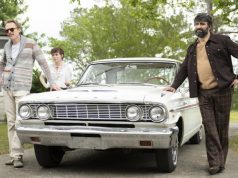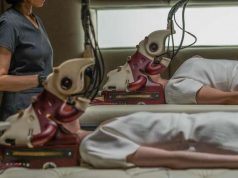Neil LaBute’s first two films, “In the Company of Men” (1997) and “Your Friends & Neighbors” (1998), focused on selfish, cruel characters capable of committing unspeakable acts of social inhumanity. After sidetracking with “Nurse Betty” (2000) and “Possession” (2002), LaBute the misanthrope is back to form with “The Shape of Things.” Here, as in his earlier work, we have a lesson in human cruelty.
The loose cannon is Evelyn (Rachel Weisz), an art major at California’s fictional Mercy College (the name of the school is no doubt ironic). When we meet her, she is about to deface a nude statue that has been covered up due to prudishness; with a can of spray paint, she intends to re-draw what a plaster fig-leaf has obscured. The censorship offends her, though her de-censoring will offend others.
Making weak attempts to stop her is the museum’s security guard, Adam (Paul Rudd), a nerdy, slightly chubby weakling. They have a conversation, which leads to a date, which leads to Evelyn taking over Adam’s life entirely. She prompts him to lose weight (Rudd wore makeup and a fat suit in the early scenes), get contact lenses and stop biting his nails. Then the changes become more drastic, affecting his long-time friendship with a sweet girl named Jenny (Gretchen Mol) and her macho fiance Phillip (Fred Weller). In the Bible, Eve was created from Adam. Here, Eve does the creating and Adam is the finished product.
LaBute is a writer first and a director second. What he does visually is unobtrusive and functional, but what he does with words and structure is wonderful. The word “thing,” with its many imprecise definitions, shows up often, and the title of the film is spoken twice, both times by the same character, but each time with a different meaning. The dialogue brims with cultural references and personal invective, much of which is caustically funny.
Two things about the film strike me as particularly interesting. One is that it only has 11 scenes, in 11 locations, compared with the 50 or 60 that most movies its length might have. This is because LaBute has adapted the script from his own play without really changing it, resisting the temptation some writers have to “expand” their plays into something more cinematic and less theatrical.
The other interesting thing is that it only has four speaking roles. It hadn’t occurred to me that the cast was so small until the credits rolled and I only saw four names. It doesn’t seem quiet and claustrophobic, like many small-cast films do.
The performances are well-honed and precise — all four actors played the roles in the stage version, too — but LaBute’s intriguing concepts are also the source of his stumbling. The nature of what he has written is that we are less interested in the characters themselves than in what they might do to each other. The mechanism is the thing, not the people caught in it, and that lessens some of the film’s impact. Or, from another point of view, it makes us as uncaring toward the characters as they sometimes are toward each other.
B+ (1 hr., 37 min.; )





